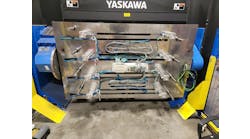The use of robotics in factories continues to proliferates, especially since the COVID-19 pandemic showcased the benefits of digital technologies. In this episode of Control Intelligence: The podcast from Control Design, editor in chief Mike Bacidore speaks with Omron Automation’s Alex Bonaire about how robotics controllers and software solutions are being implemented today.
Transcript
Mike: Hello, and welcome to today's episode of "Control Intelligence." I'm Mike Bacidore, Editor in Chief of Control Design, and your host for today's podcast. In this episode, I'm joined by Alex Bonaire, who is product manager of robotics at Omron Automation. We'll be talking about robotics controllers and software solutions being implemented in factories.
Bonaire began his professional career as a research consultant for an automotive manufacturer in Detroit, researching vehicle assembly methods. It was there that he was first introduced to robotics. And from that point, it quickly became apparent that working with robots was far more appealing than conducting research, inevitably resulting in a decision to focus exclusively on robotics work. Beginning with applications in automotive, the ensuing two decades saw Alex progressively expand his experience into nearly every industry that employs robotics and automation, including pioneering work with agricultural automation. Over his career, he's worked for several of the largest robot manufacturers in the world, and held titles ranging from intern to manager. Welcome, Alex.
Alex: Thanks, Mike. Appreciate you having me.
Mike: Alex, as I'm sure you know, factories are looking more closely at robotic solutions to address some very complex challenges in manufacturing. What sorts of tools are you seeing manufacturers requesting at this point?
Alex: What we're seeing, and it's been a trend for some time, and it just continues to grow, especially with current market conditions, is that they're trying to be able to do more with less. They want to be more efficient with the tools that they're purchasing to help their manufacturing. Performance is important—to be able to get more throughput through their manufacturing lines. But they're also looking for things that are easier to use—products that are more intuitive to the user. Software and hardware that work seamlessly together is a good example of that—easy to connect and set up. And they’re also looking to have the tools in place for the staff that they do have available to work on these projects and these systems, to be able to access those systems more easily, even if they might not be local to that particular facility. With the rise in remote work, we're seeing more of that happen with manufacturers in the factories and those manufacturing systems.
It's a little bit of a culture shift for many of those manufacturers, because they're very focused on having local resources, but now, with the challenges that they're facing with labor shortages and being pressured to continue to produce as much as they are, they're starting to embrace more of these technologies that allow them to do more, even remotely.
Mike: Certainly, and especially with the shutdown, and then the labor shortage, that certainly heightened the interest, I'm sure, in different automated solutions to help to relieve some of that pressure for production. There are a variety of robots—SCARA, parallel, articulated, collaborative—and we're seeing more of the autonomous robot applications that are mobile. The operation of all of these is very complex. How important is it to integrate the vision and the motion and the safety, as well as integration with other robots, even, in certain applications?
Alex: It's very important, especially in situations where you really need to have your system performance as best as possible. When you have discrete systems that are talking to each other, there's time lost in that communication. They're literally talking different languages, and having one translate to the next in terms of commands and signals, that takes extra time. And there isn't the integration and the coordination of those different systems together when they're separate systems. So, when you get a platform similar to what we have recently launched, with the integrated controller, automation controller, you're able to actually put everything on one single CPU, which is the brains for the entire operation, so that communication lag isn't there. You're able to very closely tie the operation of a servo-driven conveyor belt or external axes with a robot, and have those work together seamlessly, without that loss in time for the communication.
And you're also in the same program, so you don't have to wait for one program to do its thing and then have the other program look for that signal and then pick it up. It's all in one spot, which not only helps the performance, but then helps the manufacturer's staff have an easier time setting that up and troubleshooting. So, they don't have to do a complex type of data trace to try to see what's happening with the robot. Is the hang-up in the operation because of the robot's seeing a wait somewhere, or is it because there's a sensor going kaflooey because it's an intermittent signal? It's all in one spot, so it's very easy to be able to pick up where there might be a gap in the program or an error in the physical process. So, it's very important in terms of getting the performance that people want with their solutions and being able to do a better job of operating that in the lifecycle of that solution for the customer.
Mike: That certainly streamlines everything and simplifies a lot of those complex tasks that used to take literally days, if not weeks, in order to coordinate or troubleshoot. As these industrial challenges and their solutions continue to change so rapidly, I'm sure it would be really helpful to be able to test solutions before rolling them out for full implementation across multiple facilities. Can you talk about the advantages, and maybe even disadvantages, of software simulation versus, say, a proof-of-concept testing center?
Alex: For many, many years, now decades, the go-to strategy for many automation solutions was to set up a proof-of-concept mockup of that application, to validate whether or not it can actually be done. It’s something that we still do today. Customers will bring us samples of their parts, we put them under a vision system, or we pick it up with a robot, or vision and robotics together, to see if it is a viable solution. Is it a viable candidate for an automation solution? Most of the times, it is. Sometimes it's not. There are always these nuances to how parts are in the real world that are hard to replicate in a simulation.
But recently, with the advancement of some of the software tools that we've developed, we're very close. So, even though there's still a need for physical proof of concept to take into account things like the physics and the condition of the part itself, we're able to do a whole lot ahead of time on the software side. And that's very helpful for us to be able to use those tools to show prospective users of our technology what they can do before they actually pull the trigger and get a full automation solution from us. But even for those customers who are using our software, it's very helpful for them to be able to speed up their deployment of their automation solutions, because they can do 80% to 90% of their testing and their programming before they even put the first bolts into their physical hardware, or even take delivery of their hardware.
They can get to the point where they have a really good feeling for how their system is going to operate and be ready, so as soon as all the hardware is there, they can hit the ground running and basically upload programs and just do the troubleshooting at that point. It's very helpful to be able to see how those machines are going to be able to run in a virtual world, so you can get a sense of that operation and head off any potential pitfalls that might occur. For instance, you have a position of a robot relative to a machining center. It could have been placed incorrectly in CAD because CAD didn't necessarily know what the work area of the robot was. But in the actual simulation, it does take into account that work area, and the physical operation of that robot as it would be in the real world, so it's very helpful in that regard.
Mike: Sure. It seems almost as if software is just consuming the physical world. In so many respects, it's replacing hardware and simplifying tasks that once required a full staff of engineers and technicians. How advanced has software become? What is it already capable of, and what do you foresee in the future of software?
Alex: We're at the point with our Sysmac Studio product where we're able to simulate an entire work cell. Previously, we were able to do robot systems, but now we're able to pull the custom designs of our users into the system and actually have those mechanical systems work as they would in the real world. If somebody were to design an x-y-z table that is next to a CNC machining center that connects to an upstream and downstream conveyor system, where a robot is picking and placing on those, all of that can be set up in the simulation, including the sensors and the vision systems that would be used there. That ends up being a complete digital twin of that system and you can see how that's running in the real world, even if you're not there. Somebody can be remote and have a virtual representation of the real machine running 10 miles away, 1,000 miles away, and be able to help and troubleshoot that online or offline, remotely.
And then there are also tools in place to have performance monitoring and preventive maintenance measures that provide some extra intelligence for customers to be alerted to when something's going to happen before it happens, so that they can encounter less overall downtime. What we're seeing is these small bits and pieces of software, of functionality being added, where the combination of the visualization, the remote access, the performance monitoring tools and even some tools with AI in there that allow customers to be able to get a better control of their systems and be able to operate those as efficiently as possible. In the future, we're just going to keep adding more of that intelligence to that software. It becomes a point where it's more of a conversation. The software prompts you: “What do you want to do?” and it has the intelligence to understand what you're looking for, based on how you configured the system. It's very exciting.
Mike: It's always mind-boggling just how far we've come and how much some of those science-fiction movies of the '60s and '70s and even '80s are actually just reality today, just the way that we're able to interact with different types of artificial intelligence within the machines.
Alex: Back in the day, you used to have to program every discrete function. And that's all the system would ever do. Now it's more of the context of the application. And then that's understood by the system.
Mike: That expertise has already been captured, and now you just interact with it. So, at the core of pretty much every robotic solution is the controller. It interfaces with sensors, actuators, and even management reporting systems, not to mention other robots. What sort of system architecture do you recommend that would be best for integrating multiple devices in an application such as a high-speed packaging line?
Alex: This goes back to the importance of having an integrated solution that encompasses all of your automation disciplines. The more that controller can do in one spot, the more efficient that application, that process, is going to be. There's less of that communication back and forth between the systems. It's one native program talking the same language. It's reducing the number of cooks in the kitchen, for lack of a better term, to having one single brain for the system. It's that master controller that sequences everything. You don't have to worry about configuring multiple devices in that way. The newly released product that we have, the Robotics Integrated Controller, is a product that does that. It's a machine automation controller that is able to control vision, robotics, external motion, many axes of external motion, many robots, safety and database connectivity to connect to the plant systems. It's really your single source of machine control for systems of pretty much any size.
Mike: On that particular controller, are there any limits on the number of axes that can be controlled, and can you also talk about sharing data, with the connectivity on the network? Can you talk a little bit about how that can be configured to do that?
Alex: With the integrated controller that we have, it's able to connect up to 64 external axes of motion. You can operate up to eight individual robots. There are versions with database connectivity, for those customers who need that extra communication, and there's others that don't in case they don't need it. That helps keep things more affordable. And in terms of connecting the system to the plant systems and to each individual component, we have an architecture that uses the appropriate networks for each. Typically, when you're talking about a general plant communications network, you don't need super high speed. You don't need deterministic communication with the plant systems. We have a separate, dedicated network for general communications. But for the network to control the connected devices that require more data and are more data-hungry, that do require the deterministic functionality to be able to have better synchronization, we have a high-speed EtherCAT network that connects all of those devices. The robots, the motion axes, the vision system, that's all connected over the high-speed EtherCAT network, so that gives a very high-performance result to the devices and the overall system when it's connected with that high-speed EtherCAT network.
Mike: Some exciting answers and some exciting things going on, certainly, at Omron Automation with robotics and connectivity and control, for sure. Thanks for joining us today, Alex.
Alex: Thanks.
Mike: You bet. Thanks for joining us, and thanks to all of our listeners on "Control Intelligence," the podcast for "Control Design" magazine. Thanks, of course, to Omron Automation's Alex Bonaire, for his insights into industrial robotics solutions. If you enjoyed this episode of "Control Intelligence," don't miss our older episodes, and feel free to subscribe to new podcasts in the future. You can find our podcast library at controldesign.com, or download all of the episodes via Apple Podcasts or Google Play.





